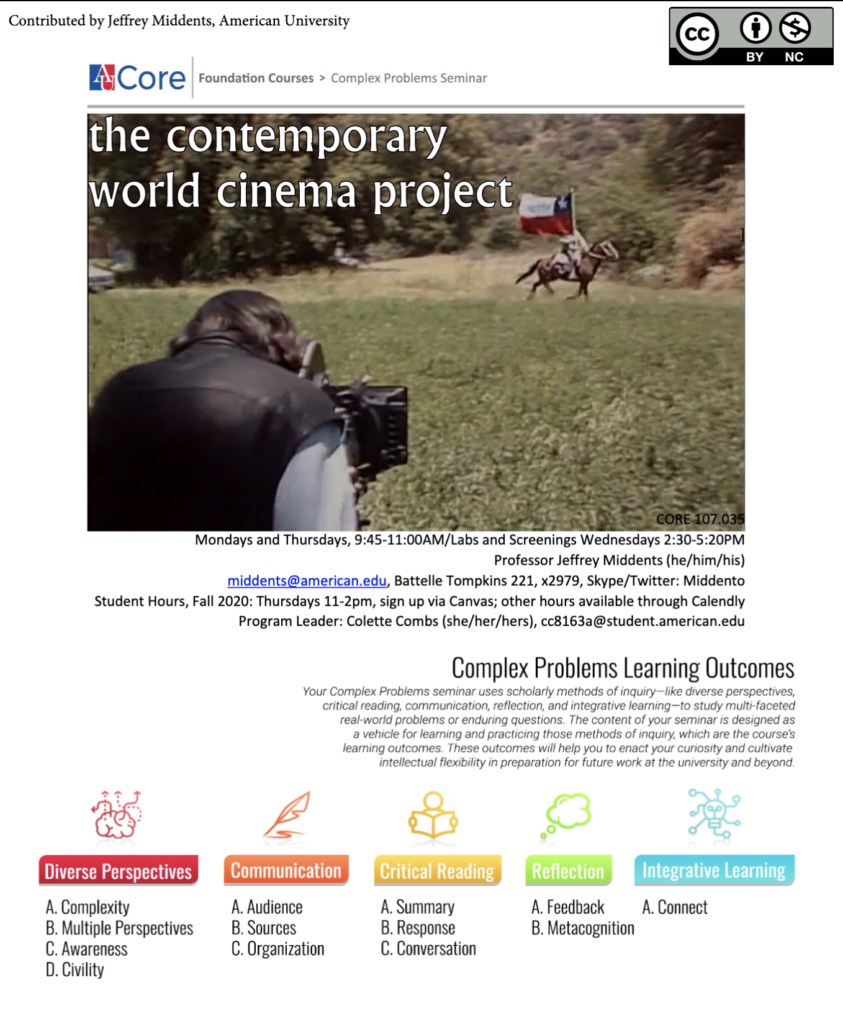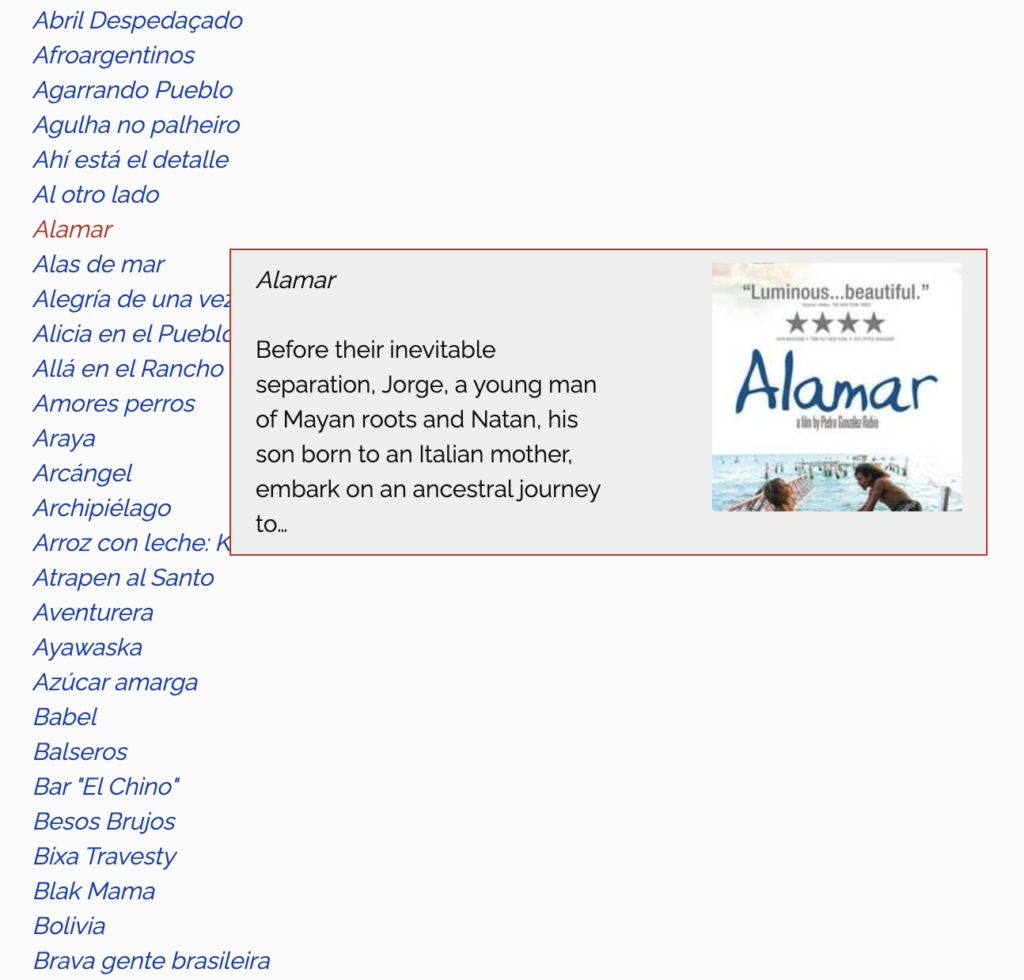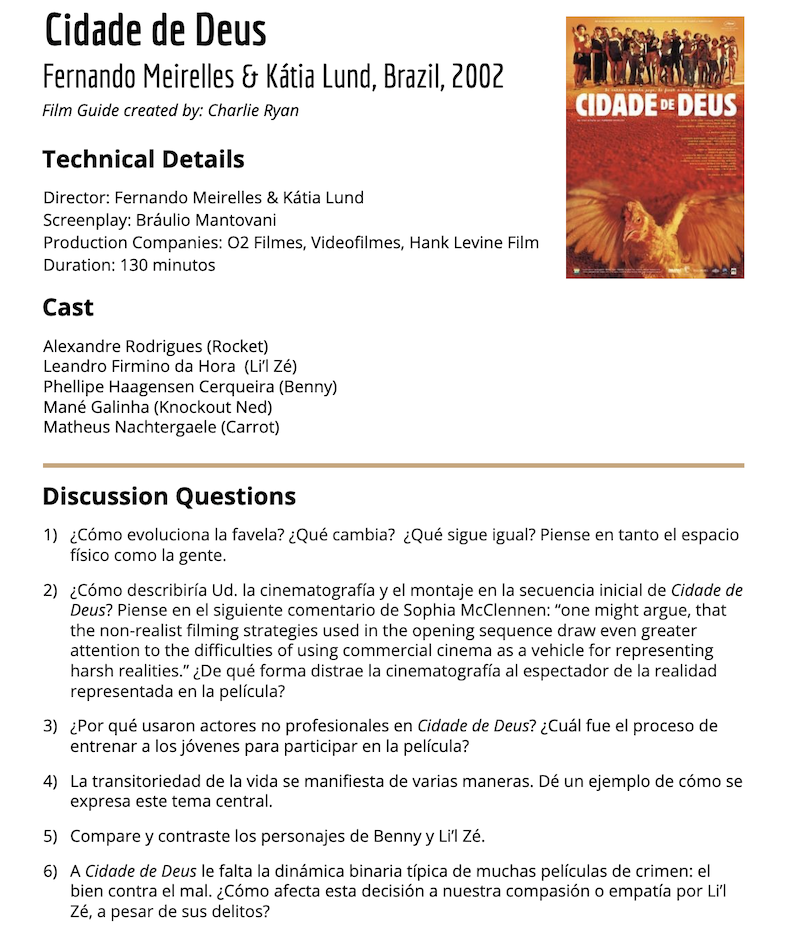
Cinegogía: Resources for Teaching Latin American Film
At Mediático we love collaboration. And in the spirit of collaboration today we are delighted to have a post from Bridget Franco, Associate Professor in the Department of Spanish at the College of the Holy Cross on Cinegogía a bilingual Digital Humanities project with a specific focus on teaching resources related to Latin American film and media.
Cinegogía: Resources for Teaching Latin American Film
by Bridget Franco, editor.
Cinegogía, a bilingual Digital Humanities project with a specific focus on teaching resources related to Latin American film and media[i], provides tools to help the scholar preparing to teach Latin American film, open-access Digital Humanities projects including:
- Syllabi
- Film Database
- Film Guides & Course Materials
- Digital Media Resources (Cineglos & Video Essays)
Cinegogía maintains the conceptual model pioneered by earlier web projects such as Cinergia (2000- 2007, created by Sophia A. McClennen) of sharing teaching resources related to Spanish-language cinema In addition to collections of teaching resources such as syllabi and film guides. Cinegogía includes thematic modules with annotated bibliographies, a searchable Latin American film database, and resources for creating video-essays and videographic scholarship. The project’s infrastructure provides precise search and filter capabilities, stable results, and, thanks to collaboration from scholars in the field, a robust database of current teaching materials that reflect an array of approaches, assignments and film selections. The platform is mobile-friendly so that searches can be conducted and content can be easily viewed on iPads, iPhones and other mobile devices with an internet connection. One of Cinegogía’s strengths as a curated repository of pedagogical materials is the ability to search and filter to a high degree of precision across countries, topics, genres, films, directors, cinematic periods, production companies, and language. The curated metadata allows users to find resources that are tailored to their particular focus, thus facilitating a wide array of approaches to teaching Latin American Film.
1. Syllabi
Cinegogía’s collated syllabi contain a trove of information that reveals the vast ways Latin American cinema is taught in the United States and abroad. These carefully crafted documents include course objectives, curated film selections, recommended readings, writing assignments, media resources, and detailed weekly schedules. For instructors who teach Latin American Film in language, history, or political science departments and who might not benefit from casual conversations with colleagues about their course content, access to syllabi provides important insights into a variety of approaches to teaching Latin American film. In addition, syllabi contain well-worn pedagogical methods that have worked successfully, and innovations in teaching film that are being developed at the undergraduate and graduate levels.

Cinegogía dozens of sample syllabi, in English and Spanish, include courses with a national focus (Cuban Film, Clásicos de la época de oro del cine mexicano, National Cinema Study: Mexico, El cine argentino contemporáneo); transnational and world cinema approaches (Contemporary Spanish and Latin American Cinema, Cine hispano, The Contemporary World Cinema Project, Transnational Cinema); broad surveys (Latin America through Cinema, El impulso documental en el cine latinoamericano, Latin American Cinema: 1930 to the Present); thematic organization (Inmigración en el cine, Representation of Children and Adolescents in Argentine, Colombian and Mexican Cinema); and identity studies (Chicana/o and Latina/o Representation in Cinema, Latin American Women Writers and Filmmakers, Transgressive Gazes across the Americas).
Cinegogía’s digital platform allows these resources to be accessed freely in one location and updated frequently to reflect ongoing trends and emerging innovations in teaching film. Our research team culls the film titles from each published syllabus and adds these entries to the database.
2. Film Database

Cinegogía’s database includes over 400 Latin American film entries that can be searched and filtered by country, director, genre, cinematic period, subject coverage, production company, and specific tags. The unique metadata curation, designed for and by educators, allows users to find resources that are tailored to their particular focus, thus facilitating transnational, regional, and comparative approaches to teaching Latin American Film Studies. For example, a search for films categorized under the subject “gender identity” and further filtered by particular countries or time periods would produce a filmography with potential titles that a user might not have considered. The film database can be searched in a number of different ways: browse the entire collection, narrow results by specific topics or subjects, explore a visual map of descriptive tags, or use the advanced search function to filter through the entire dataset. There are many excellent national film databases already in existence (for example Argentina’s cinenacional.com, Mexico’s Filmoteca UNAM, and CineChile), however, they are limited by definition to country-specific cinema. Cinegogía’s film database does not pretend to be exhaustive, rather we focus on Latin American films that are frequently taught and readily available outside their country of origin. More recently, the database team has also focused on including more films with indigenous and Afro-descendant representation that may not have benefitted from the visibility afforded by state-sponsored systems of funding and production. Finally, the metadata categories and database content are curated by Latin American Film Studies specialists who provide an additional layer of description and tagging that enhances the more technical details included in national film databases.
3. Film Guides & Course Materials

Cinegogía also features a collection of over 100 film guides, in Spanish and English, with discussion questions and recommended readings for a variety of frequently- and recently- taught Latin American films. The discussion questions touch on cinematographic techniques, narrative structure, character development, sociopolitical and historical contexts, thematic interpretations, relevance to current events, and connections to other films. The film guides can be used as post-screening writing prompts or exam questions, as well as to generate discussion in class or on asynchronous discussion boards. Instructors can also integrate the creation of an original film guide in their course, using Cinegogía’s “Best Practices and Guidelines” and working with students to develop and submit a film guide for consideration. This activity is a practical and accessible way for undergraduate students to publish their work. In addition to the Film Guide collection, the Course Materials page brings together thematic filmography lists, guidelines for writing film reviews, exam questions, essay instructions, assessment rubrics, articles on pedagogy, a student guide to film concepts in Spanish, annotated bibliographies, and two recently developed resources focused on Indigenous and Afro-Latin American representation in Latin American film and filmmaking.
4. Digital Media Resources (Cineglos, Video Essays)
While the syllabi, database and film guide collections are text-centric, Cinegogía also houses two teaching resources that utilize moving images as their primary modality. The first is Cineglos, a Spanish-language cinematographic glossary that incorporates media clips from Latin American and Spanish movies to illustrate particular film techniques or concepts (Franco). Among the many English-language print publications that explain the language and art of cinematography using Hollywood productions, Cineglos stands out as a Spanish-language digital resource that draws its references exclusively from Latin American and Spanish films. For example, a scene from Patricio Guzman’s La batalla de Chile illustrates the blurry wiping motion of a zip pan (barrido), while on a single page, clips from Novia que te vea, La mala educación, Memorias de subdesarrollo, Rodrigo D: no futuro, Madeinusa, El hijo de la novia, El jardín de Edén, Lengua de las mariposas, and La historia oficial illustrate the difference between shots or planos known as americano, cenital, congelado, punto de vista, especular, holandés, largo, medio, and primero, respectively.

The second media-centric teaching resource is the Video Essays module. Recent years have seen the growth of videographic criticism, a field that approaches the study of moving images by using the very same medium as a tool for analysis. Accompanying the expansion of videographic scholarship, instructors have developed student-centered projects that transform written essays into video-essays by sampling moving images and audio from the film(s) in question to create a videographic commentary. Students learn how to cut and edit media, develop storyboards, and narrate voice-overs to produce digital projects that analyze and interpret cinema on its own terms. As Nicolas Poppe of Middlebury College notes, “Videographic criticism allows us to not simply write on films, but with them.” The Video Essay module provides guidelines for several kinds of assignments, ranging from a 1-minute videographic mosaic, to a 4-minute explanatory video essay about specific cinematographic terms, to a 10-minute videographic research project developed over an entire semester. You will also find examples of select student projects, in English and Spanish, that focus on Latin American films.
One of the strengths (and potential weaknesses) of Digital Humanities projects is their dependence on collaboration with experts in the field and the constant, often times unacknowledged and invisible, work of expansion and maintenance that ensures accurate and current public-facing content. The quality of any digital repository depends on the active engagement and contribution of educators and scholars who teach and research in the field. To this end, Cinegogía operates in collaboration with a rotating Editorial Board comprised of Film Studies scholars who represent an array of disciplines, institutions, and research agendas. Cinegogía publicly recognizes the support of scholars and educators on the website. If you are interested in collaborating with Cinegogía within a particular specialization or area of interest, please contact our team at cinegogia@gmail.com or via the Collaborate link, https://cinegogia.omeka.net/collaborate.
[i] The Society for Cinema and Media Studies, lists Cinegogía as a top resource under their “General Teaching Resources” section of the main website.
Works Cited/Further reading on Latin American Teaching Resources
Afinoguénova, Eugenia, Samuel Amago, and Kathryn Everly, editors. Vademécum del cine iberoamericano: Métodos y teorías, special issue of Hispanófila, vol. 177, Spring 2016.
Baugh, Scott L. “Latin American History and Critical Media Studies: Curricular Explorations.” Film & History, vol. 34, no. 2, July 2004, pp. 65-85.
Fiormonte, Domenico, et al., editors. “Conclusions: DH in a Global Perspective.” The Digital Humanist: A Critical Inquiry. Punctum Books, 2015, pp. 207-218.
Foster, David William, Benjamin Fraser, and Bill VanPatten, guest editors. The Scholarship of Film and Film Studies, special issue of Hispania, vol. 98, no. 3, September 2015.
Franco, Bridget V. “Cineglos.” Vademécum del cine iberoamericano: Métodos y teorías, edited by Eugenia Afinoguénova, Samuel Amago and Kathryn Everly, special issue of Hispanófila, vol. 177, Spring 2016, pp. 277-282.






